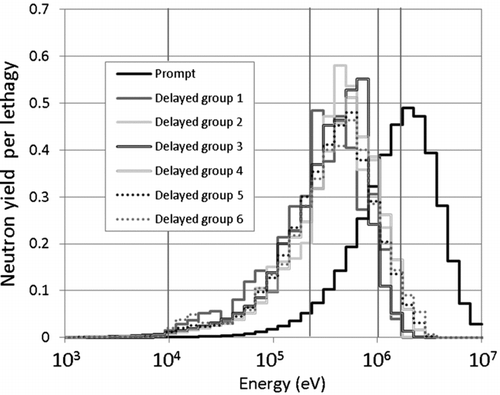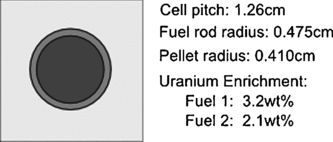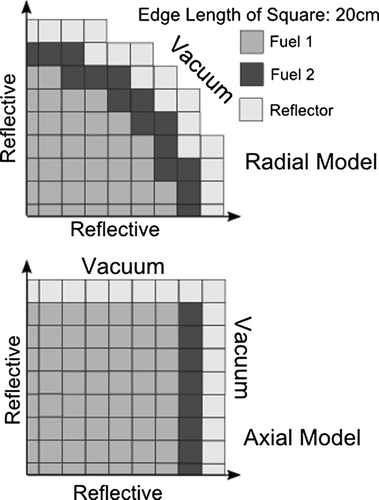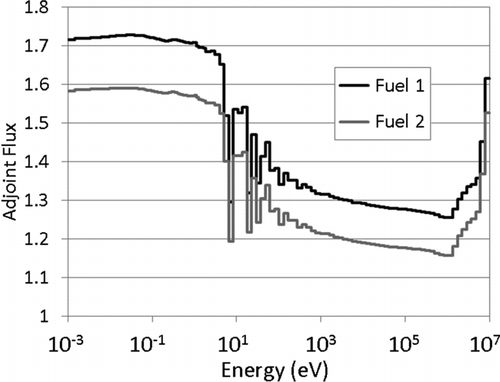Abstract
In this study, an improved method for calculating the effective delayed neutron fraction of a core with a few collapsed energy groups has been developed. To accurately calculate the effective delayed neutron fraction of a core using the conventional method, a structure with several energy groups is needed for the fast energy region in order to reflect the difference in the fission spectra for prompt fission neutrons and delayed neutrons. On the other hand, a structure with only a few energy groups is needed for the criticality evaluation. Thus, the calculation cost increases for the effective delayed neutron fraction calculations owing to the need for a large number of energy groups. To solve this problem, in the present study, the error mechanism for the effective delayed neutron fraction calculation using a structure with only a few energy groups was studied, and it was found that the error results from the collapse of the fission spectra after the cell calculations without adjoint flux weighting. In addition, an improved method for the collapse fission spectra with an adjoint flux obtained by one-point calculation was developed. Using the proposed method, the effective delayed neutron fraction can be estimated with sufficient accuracy using a structure consisting of only a few collapsed energy groups. This result will contribute to reducing the calculation cost and/or improving the accuracy of effective delayed neutron fraction calculations.
1. Introduction
The accuracy of the effective delayed neutron fraction is important because it is a measure of reactivity. For example, the inhour equation is written as follows:
ρ: Reactivity | |||||
Λ: Generation time | |||||
| |||||
λ i : Decay constant for the delayed neutron precursor of the ith group | |||||
T: Reactor period | |||||
In general, the generation time is small and the first term of Equation (1) can be ignored. Equation (1) is rewritten as follows:
The value of reactivity is almost proportional to the value of the effective delayed neutron fraction. Even if the reactor period can be estimated without error, the measured reactivity (e.g., the control rod worth) has the same relative error as the effective delayed neutron fraction. Thus, it should be possible to estimate the effective delayed neutron fraction with the same high accuracy as that of the criticality measurement.
In general, the core calculation requires a few energy groups for the criticality estimation. Particularly for a thermal reactor, a structure with two energy groups is sufficient to obtain an accurate multiplication factor. On the other hand, for the effective delayed neutron fraction, a structure with several energy groups is needed for the fast energy region in order to reflect the difference in the fission spectra for prompt fission neutrons and delayed neutrons. For example, there is a precedent for employing an energy group number of 12 [Citation1] to treat the delayed neutron fission spectrum. If the effective delayed neutron fraction calculation can be performed with sufficient accuracy using a structure with only a few energy groups, the core calculation cost, which is basically proportional to the energy group number, will be reduced to less than half.
In the present study, the error mechanism for the delayed neutron fraction was elucidated and an improved method was proposed and demonstrated numerically. In Section 2, the error mechanism for the delayed neutron fraction calculation is described. In Section 3, the improved method is proposed. First, a method is proposed for collapsing the fission spectrum after the cell calculations with an adjoint flux weighting. Second, a method is proposed for collapsing the adjoint flux that is needed for collapsing the fission spectrum and the weighting value for the collapse of the adjoint flux is discussed. In Section 4, numerical demonstrations are presented using the conventional and proposed methods.
In addition, energy groups structures were set as outlined below. A structure with fine energy groups was used for the cell calculations and could also be used for the core calculations. The number of energy groups was approximately 100 or more. A structure with a few energy groups was used for the core calculation, which was determined only for the criticality. The number of energy groups was approximately 2–5. A structure with several energy groups was used for the core calculation to accurately estimate the effective delayed neutron fraction. The energy group structure was fine in the fast energy group to treat the difference in the spectra for the prompt and delayed fission neutrons. The number of energy groups was approximately 6 to 15.
2. Conventional procedure for calculating the effective delayed neutron fraction and its error mechanism
In general, to estimate the effective delayed neutron fraction, the following definition is used:
βeff: Effective delayed neutron fraction | |||||
β: Physical delayed neutron fraction | |||||
νΣ f : Macroscopic production cross-section | |||||
χ: Fission spectrum of all of the neutrons | |||||
χd: Fission spectrum of the delayed neutron | |||||
φ*: Adjoint flux | |||||
φ: Forward flux | |||||
The bracket notation indicates an inner product that corresponds to an integral over the entire energy and space. The denominator represents the total neutron importance for the neutron generated by the fission reactions in the entire core. The numerator represents the delayed neutron importance for the neutron generated by fission reactions in the entire core. Thus, the delayed neutron fraction represents the fraction of the importance of the delayed neutron generation to that of the total neutron generation.
The concrete calculation procedure for the numerator and denominator is commonly described as follows:
For the multigroup theory, the adjoint flux, fission spectrum, macroscopic cross-section, and flux are energy vectors. To estimate the right-hand side of Equation (4), the inner product of the adjoint flux and the fission spectrum, and the inner product of the macroscopic cross-section and the flux are estimated first. Second, the product of the two inner products is estimated. Finally, the products are integrated for the entire core space. In general, the production of the inner product of the macroscopic cross-section and the flux is not estimated directly using cell calculations. The inner product is estimated in the core calculations using the macroscopic cross-section collapsed by the flux of the cell calculations. In the same manner, the fission spectrum must be collapsed by the adjoint flux of the cell calculations in order to preserve the inner product in the core calculations.
The spectra of the prompt fission neutrons and the delayed neutrons of 235U are shown in Figure . A difference appears mainly in the fast energy region. Therefore, the energy group structure in the fast energy region must be divided into several groups for the core calculations in order to use the conventional method. To improve the accuracy of the core calculations with a structure consisting of only a few energy groups, the error mechanism must be elucidated for the conventional method.
In general, the criticality calculation for the reactor is divided into two parts: cell calculations and core calculations. The cell calculations are performed to provide the cross-section for the core calculations. The procedure for performing the criticality calculations in the SRAC [Citation2] representative neutronic calculation code system is described below.
First, the cell calculations based on the integral neutron transport theory [Citation3] are performed, and the effective cross-sections and the flux in each region are estimated. At this stage, the energy group structure is a fine energy group structure. Second, with the homogenized effective macroscopic cross-sections generated using the cross-sections and the flux obtained in the first step, the one-point calculation of the P1/B1 equation [Citation4] is performed to treat the leakage effect with buckling when the leakage effect cannot be treated directly in the cell calculations. Using the flux obtained with the P1/B1 point calculation, the cross-sections are collapsed to a structure with only a few or several energy groups. The fission spectra of total neutrons and delayed neutrons are also collapsed.
After the cell calculations, the core calculations are performed using the macroscopic cross-sections generated using the cell calculations. The criticality calculations are performed for the forward and adjoint problems. The effective delayed neutron fraction is then calculated according to Equation (3) using the forward and adjoint fluxes obtained using the core calculations.
For the cross-section, the collapse is performed with flux weighting. In the collapse procedure, the reaction rate is conserved if the spectra based on the cell calculations agree with that based on the core calculation for each region. However, the products of the adjoint flux and the fission spectra, which include the fission spectra of the total neutrons and the delayed neutrons, are not conserved because the collapse of the fission spectra is performed only by summation of the energy groups without adjoint flux weighting after the cell calculations. To conserve the neutron importance for the fission spectra, the fission spectra must be collapsed by the adjoint flux of the cell calculations, as mentioned above. However, there are no general rules for collapsing the adjoint flux, which is an intensive value, unlike for the forward flux, which is an extensive value. In general, reactor physical values are categorized as either intensive values or extensive values. The extensive values are directly proportional to the spatial size and energy range, whereas the intensive values do not depend on the spatial size and energy range. For example, the flux value can be summed for energy groups because it is an extensive value. However, the adjoint flux value cannot be summed because it is an intensive value. In other words, the intensive values represent certain quantities, whereas the extensive values are not associated with any certain characteristics in a particular spatial region or energy range. Therefore, to collapse a space or energy group, the intensive values are simply summarized for the range. In contrast, the extensive values must be averaged over certain intensive values because the extensive values do not include quantitative information.
Therefore, collapse of the fission spectra without adjoint flux weighting causes a large error in the effective delayed neutron fraction when a structure consisting of only a few energy groups is used.
3. Improved method for calculating the effective delayed neutron fraction
3.1. Theory and procedure
In the conventional procedure, the collapse of the fission spectra without adjoint flux weighting after the P1/B1 calculation causes an error in the effective delayed neutron fraction. Therefore, to improve the conventional procedure, the adjoint flux must be used for collapsing the fission spectra, as mentioned in Section 2. The procedure is described below. The fission spectrum represents the fission spectrum of the total neutrons and that of the delayed neutrons. To collapse the fission spectrum, it is necessary that the adjoint flux should also be collapsed as follows:
| |||||
| |||||
| |||||
| |||||
The collapsed energy group structure represents a structure with only a few or several energy groups.
The adjoint flux must also be averaged by the extensive values in order to be collapsed, as described in Section 2. There are several candidates for the extensive values, e.g., the flux, the fission spectrum of the total neutrons, the prompt neutron spectrum, the delayed neutron spectrum, and so on. In the present study, the flux obtained from cell calculations was selected for averaging the adjoint flux. Because the flux is in conjugation relation with the adjoint flux and the adjoint flux represents the importance of the neutron flux, the pair of the flux and the adjoint flux is the most basic one with the candidates. The collapse is performed as follows:
Using Equation (5) for the fission spectrum collapse, the inner product of the adjoint flux and the fission spectrum with a collapsed energy group structure conserves the inner product for the fine energy group structure as follows:
φ*χcollapsed: Inner product of the collapsed adjoint flux and the collapsed fission spectrum | |||||
φ*χfine: Inner product of the the adjoint flux of the fine energy group structure and the fission spectrum of the fine energy group structure | |||||
From Equations (5) and (7), the inner product with the collapsed energy group structure agrees with the inner product with the fine energy group structure. If there is no discrepancy in the neutron spectra for the cell and core calculations, e.g., the spectra completely coincide, the error in the effective delayed neutron fraction will be completely eliminated by this treatment.
In addition, the collapsed fission spectrum weighted by the adjoint flux can be applied only for calculations with adjoint flux weighting, such as the effective delayed neutron calculation, because the collapse conserves the inner product of the adjoint flux and the fission spectrum for the fine energy groups structure. Thus, the summation of the weighted fission spectrum does not always coincide with unity and cannot be applied to the multiplication factor calculation.
3.2. Calculation code: model and conditions
The error in the effective delayed neutron fraction using the conventional method and the effect of the proposed method have been confirmed through numerical demonstration. A typical pressurized water reactor (PWR) model was employed for the calculations. The cell calculation model is shown in Figure . To generate the cross-sections for the core calculations, the SRAC-PIJ module, which is a collision probability method code, was employed with the evaluated nuclear data library JENDL-3.3 [Citation5]. For the calculations using the SRAC-PIJ module, the neutron slowing-down calculation with an ultrafine energy group structure was performed using the PEACO module. With these modules, the fuel cell lattice calculation was performed. After the neutron slowing-down calculation, the P1/B1 point calculation was performed with geometrical buckling for the entire core region. The adjoint P1/B1 point calculation was also performed using the module developed in the present study. The collapse was performed in the same manner as described in Section 3.1.
After the cell calculations, the core calculations were performed using the model shown in Figure . The core has three regions: fuel 1 region, fuel 2 region, and the reflector region. Fuel 1 region was assigned to the center region, while fuel 2 region, which had a lower uranium enrichment than fuel 1 region, was assigned to the outer region. The uranium enrichments were 3.2 wt% and 2.1 wt% for fuel 1 and fuel 2 regions, respectively. The fuel cell pitch was 1.26 cm, the fuel rod radius was 0.475 cm, and the pellet radius was 0.410 cm. The reflector region was assigned to the region outside of fuel 2 region. The core calculations were performed using a 1/8 symmetric core geometry with the reflective boundary condition for the central surface of the core and a vacuum boundary condition for the outer side of the core. The core height was 300 cm and the equivalent core radius was 150 cm. The criticality calculation and the effective delayed neutron calculation were performed using SRAC-CITATION, which is a neutron diffusion calculation code. The module for the effective delayed neutron calculation was modified in order to implement the method proposed in Section 3.1. The neutron energy group structures are shown in Table . There were three types of neutron energy group structures. The 107-group structure was the fine energy group structure, while the 2-group structure was a practical energy group structure for the criticality calculations and was set as the structure with only a few energy groups. The 6-group structure was used for the effective delayed neutron fraction calculation using the conventional method. The fast energy group was divided into five groups in order to treat the delayed neutron spectrum. This division was determined in order to obtain an accurate effective delayed neutron fraction and was set as the structure with several energy groups. The four separators in Figure correspond to this division.
Table 1 Energy group structure
3.3. Calculation results and discussion
The effective delayed neutron fraction and the multiplication factor calculated using conventional calculations with the three energy group structures are shown in Table . The relative error was estimated by comparing these values with the values obtained when using the 107-group structure. The error in the effective delayed neutron fraction with the 2 groups structure was large (approximately 2.6%), while that with the 6 groups structure was negligible (approximately 0.02%). On the other hand, the error in the criticality was nearly the same for the two energy group structures.
Table 2 Comparison of the effective delayed neutron and multiplication factors
The calculation with the proposed method was also performed using the two energy group structures. The adjoint flux spectra based on the B1 point calculations are shown in Figure . The adjoint flux was used for the collapse. The collapsed fission spectra are shown in Table ; those based on the proposed method are less than unity because the collapse was performed with adjoint flux weighting. The accuracy of the effective delayed neutron fraction was then compared with that obtained using the conventional method, as shown in Table . The large error of approximately 2.6% was reduced to approximately 0.2% using the same 2-group structure by employing the improved method. In general, an accuracy of 0.2% is good enough when compared with the measurement error for the counting rate, which is approximately 0.5–1.0% at 1σ (standard deviation) [Citation6]. The proposed method can thus reduce the error by collapsing the fission spectrum and the adjoint flux weighting. The summation of the total fission spectrum was approximately 0.985 and the summation of the delayed neutron spectrum was approximately 0.960. The summation of the fission spectrum of the delayed neutrons was smaller than that of the total neutrons by approximately 2.5%. This effect reduces the error. The peak in the fission spectrum for the prompt neutrons, which was nearly the same as that in the fission spectrum of the total neutrons, was above 1 MeV. On the other hand, the peak in the fission spectrum for the delayed neutrons was under 1 MeV, as shown in Figure . The adjoint flux, which was used for the collapse of the fission spectrum, has a large value above 1 MeV owing to the fission threshold reaction. It was also numerically confirmed that nearly all of the errors were generated from the collapse of the fission spectrum without the adjoint flux weighting in the cell calculations, and it was demonstrated that the accuracy can be improved using the proposed method.
Table 3 Fission spectra based on the conventional and proposed methods
Table 4 Comparison of the conventional and proposed methods
4. Conclusions
The effective delayed neutron fraction is a measure of the reactivity and is proportional to it. Thus, the error in the effective delayed neutron fraction directly propagates to the measured reactivity. Therefore, the error should be reduced to the same level as that of the measured criticality.
To improve the accuracy, the error mechanism for the effective delayed neutron fraction calculation was elucidated for the conventional method. It was found that the error is caused by a lack of conservation of the product of the fission spectrum and the adjoint flux, because the fission spectra are collapsed after cell calculations without adjoint flux weighting. Moreover, it was proposed that the adjoint flux collapse method requires the collapse of the fission spectrum, thus and an adjoint P1/B1 point calculation module was developed. Using the proposed method, the error in the effective delayed neutron fraction was reduced from 2.6% to enough accurate value of 0.2% with the same 2-group structure for a typical PWR core calculation. The core design can be accomplished using a structure with only a few energy groups by employing the proposed method. This result will contribute to reducing the calculation cost and/or improving the accuracy of effective delayed neutron calculations.
Acknowledgements
The author's heartfelt appreciation goes to Dr T. Kugo, Dr N. Fujimoto, and Mr M. Goto of the Japan Atomic Energy Agency (JAEA), whose comments and suggestions were of inestimable value.
Notes
Note: Read E+XX as 10XX.
Note: Read E+XX as 10XX.
Note: “Delayed” stands for “delayed neutron precursor group.”
Note: Read E+XX as 10XX.
References
- Takamatsu , K , Nakagawa , S and Takeda , T . 2007 . Application effect of region temperature coefficients and improvement of heat transfer analysis model in HTGR . Trans Atom Energy Soc Japan , 6 : 262 – 275 .
- Okumura , K , Kugo , T , Kaneko , K and Tsuchihashi , K . 2007 . Japan Atomic Energy Agency Tokai SRAC2006: a comprehensive neutronics calculation code system (JAEA-Data/Code 2007-004)
- Tsuchihashi , K . 1985 . Collision probability in two-dimensional lattice by ray-trace method and its applications to cell calculations (JAERI-M 85-034) , Tokai : Japan Atomic Energy Research Institute .
- Durek , J S , Joanou , G D and Leshan , E L . 1961 . “ GAM-I: a consistent P1 multigroup for the calculation of fast neutron spectra and multigroup constants (GA-1850) ” . San Diego, CA : General Atomics .
- Shibata , K , Kawano , T , Nakagawa , T , Iwamoto , O , Katakura , J , Fukahori , T , Chiba , S , Hasegawa , A , Murata , T , Matsunobu , H , Ohsawa , T , Nakajima , Y , Yoshida , T , Zukeran , A , Kawai , M , Baba , M , Ishikawa , M , Asami , T , Watanabe , T , Watanabe , Y , Igashira , M , Yamamuro , N , Kitazawa , H , Yamano , N and Takano , H . 2002 . Japanese evaluated nuclear data library version 3 revision 3: JENDL-3.3 . J Nucl Sci Technol. , 39 : 1125
- Bertrand , P , Pierre , J , Martini , M , Belov , S , Doulin , V , Kotchetkov , A , Matveenko , J , Mikhailov , G , Nemoto , T , Sakurai , T and Spriggs , G . 1996 . “ BERNICE – interlaboratory comparison of βeff measurement techniques at MASURCA ” . In Proceedings of the International Conference on the Physics of Reactors, PHYSOR ’96 , 2 Ibaraki-ken, Japan: Japan Atomic Energy Research Institute; E-190 . 1996 Sept 16–20. In: Osugi T, Oigawa H, editors.



